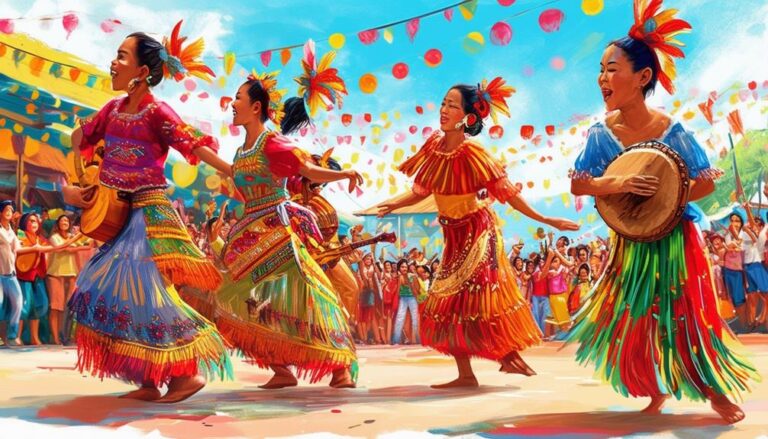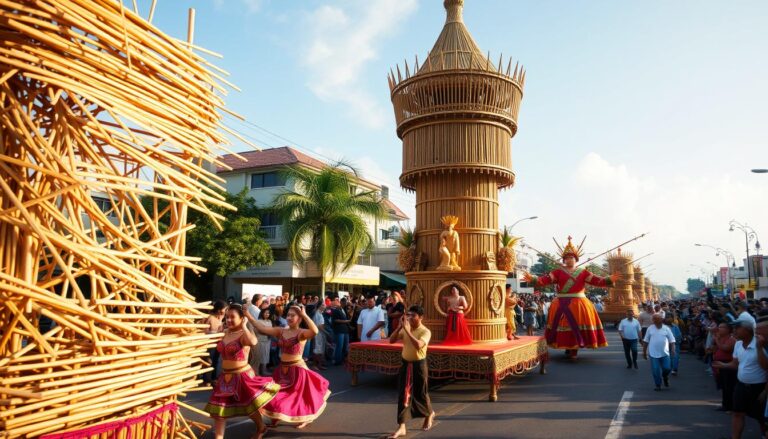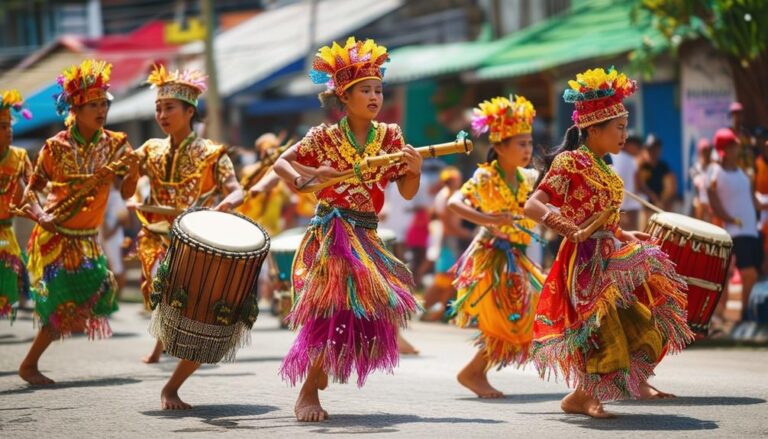Taong Putik Festival: Nueva Ecija’s Taong Putik Festival: Full Guide

Every June 24, the quiet town of Bibiclat in Aliaga transforms into a living tapestry of devotion. Locals honor St. John the Baptist through a striking tradition: covering themselves in river mud and dried banana leaves. This practice, rooted in gratitude for divine protection during World War II, has become one of Central Luzon’s most visually arresting cultural events.
The celebration traces its origins to 1944, when villagers facing execution by Japanese soldiers prayed for mercy. According to oral histories, a sudden downpour allowed them to escape disguised as mud people – a miracle attributed to their patron saint. Today, this story comes alive through processions where participants reenact the historic escape while carrying religious icons.
Modern iterations of the event blend solemn rituals with vibrant community gatherings. After dawn masses, devotees walk barefoot through streets seeking alms – a symbolic act of humility. The Diocesan Shrine of Saint John the Baptist, recognized in 2013, serves as the spiritual heart of these activities.
Key Takeaways
- Held annually on June 24 in Bibiclat, Aliaga, Nueva Ecija
- Participants wear mud-coated bodies and natural fiber costumes
- Originated from a WWII survival story involving miraculous rainfall
- Combines religious processions with cultural performances
- Recognized as an important heritage preservation effort
- Accessible via 3-4 hour bus ride from Manila
- Adapted safety measures for modern participants
History and Significance of the Taong Putik Festival
A miraculous escape during Japanese occupation laid the foundation for an enduring cultural practice. In June 1944, tensions peaked when local guerrillas attacked occupying forces. As retribution, soldiers gathered Bibiclat residents for execution near a rice field.
Wartime Miracle and Origins
Elders recount how prayers to St. John the Baptist intensified as rifles were raised. Without warning, torrential rains drenched the area – a downpour so fierce it obscured vision. Soldiers abandoned their plan, interpreting the storm as divine intervention.
This watershed moment became central to community identity. Survivors used wetland mud as camouflage during their escape, creating the first “mud people.” Annual reenactments began the following year on the saint’s feast day.
Devotional Practices and Symbolism
The ritual mud application carries dual meaning. It recalls wartime survival tactics while mirroring baptismal purification from Christian teachings. Participants often carry candles during processions, representing light through darkness.
Local churches integrated the practice into June 24 observances after recognizing its spiritual resonance. Through generations, the event evolved from personal gratitude to organized faith expression – uniting the village in shared history and devotion.
Cultural Traditions and Local Legends
In Bibiclat, natural materials transform into sacred symbols during June observances. Locals craft their attire using river clay and banana leaves, creating living representations of spiritual values. These elements connect modern practices to biblical narratives and wartime survival stories.
The Role of Mud and Dried Banana Leaves
Participants coat their skin with thick mud before sunrise, a process symbolizing rebirth and equality. Dried banana leaves are soaked in water, then shaped into waist coverings resembling St. John the Baptist’s simple garments. This tactile tradition teaches younger generations about resourcefulness and humility.
| Element | Symbolic Meaning | Practical Purpose |
|---|---|---|
| River Mud | Purification & Unity | Sun protection during processions |
| Banana Leaves | Connection to Nature | Biodegradable costume material |
| Alms Collection | Community Support | Funds church maintenance |
Miraculous Stories and Community Faith
During the feast, residents walk barefoot while collecting alms – candles and coins placed in coconut shells. One enduring legend tells of a 1953 procession where participants allegedly found hidden Japanese weapons buried along their route. Many view this as the saint’s continued protection.
These traditions strengthen communal bonds while attracting tourists interested in living history. Older residents share wartime escape stories with children, ensuring oral histories survive. Through mud and leaves, Bibiclat keeps its spiritual legacy alive across generations.
Experiencing the Festival: Activities and Participant Perspectives
At dawn’s first light, Bibiclat stirs with purposeful movement. Barefoot figures emerge coated in earth-toned clay, their silhouettes mirroring biblical ascetics. This transformative ritual bridges past and present through vivid sensory experiences.
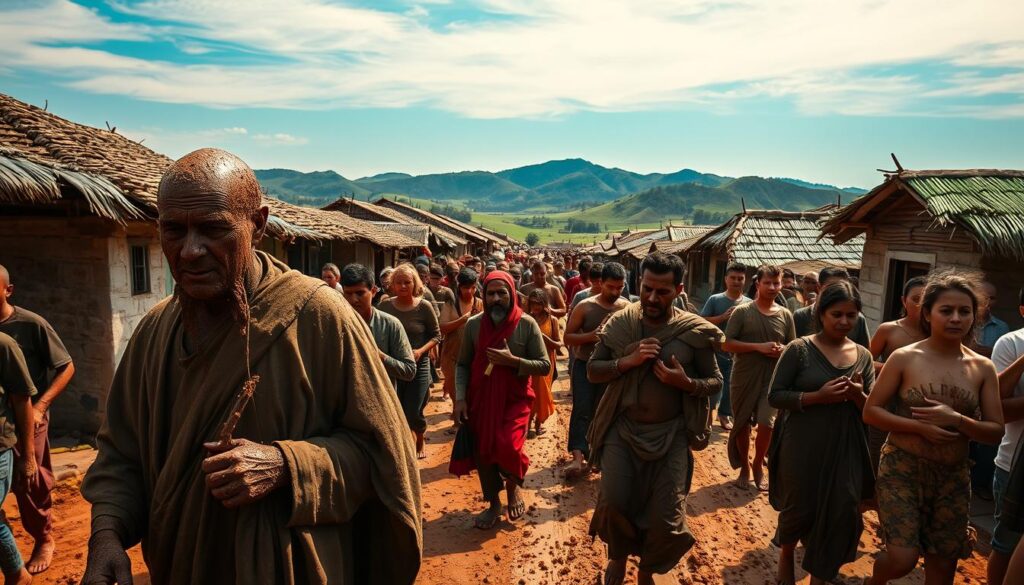
Processions, Rituals, and Offerings
Devotees begin assembling before sunrise, their bodies draped in dried banana leaves soaked in river mud. The procession route becomes a moving tapestry of faith as participants chant prayers to San Juan Bautista. Villagers line the path, placing candles and coins into coconut shells carried by the mud-coated marchers.
Three key elements define this ritual journey:
- Alms collection supporting church maintenance
- Barefoot walking symbolizing humility
- Group recitations of wartime survival stories
Many participants describe feeling “reborn” during the march. “The mud cools your skin but warms your spirit,” shares local farmer Andres Cruz, a third-generation devotee.
Costumes and Artistic Expressions
Natural materials take on sacred meaning in festival attire. Dried banana leaves are carefully selected and woven into waist coverings resembling St. John the Baptist‘s simple garments. Modern organizers now provide hypoallergenic mud mixtures while preserving traditional application methods.
Key costume components include:
- River clay mixed with coconut oil for skin protection
- Vine-wrapped bamboo torches carried by night
- Palm frond headpieces symbolizing martyrdom
After the procession, participants wash off their clay coatings in the same river where Japanese soldiers once patrolled. This cleansing ritual completes the cycle of devotion, leaving skin clean but hearts marked by the experience.
Travel Guide to Bibiclat, Aliaga, Nueva Ecija
Bibiclat offers visitors a rare glimpse into living traditions rooted in devotion to St. John. This nueva ecija village celebrates its spiritual heritage through immersive experiences, where travelers witness locals ask alms while draped in dried banana fibers. Early arrival ensures full participation in rituals tied to San Juan Bautista.
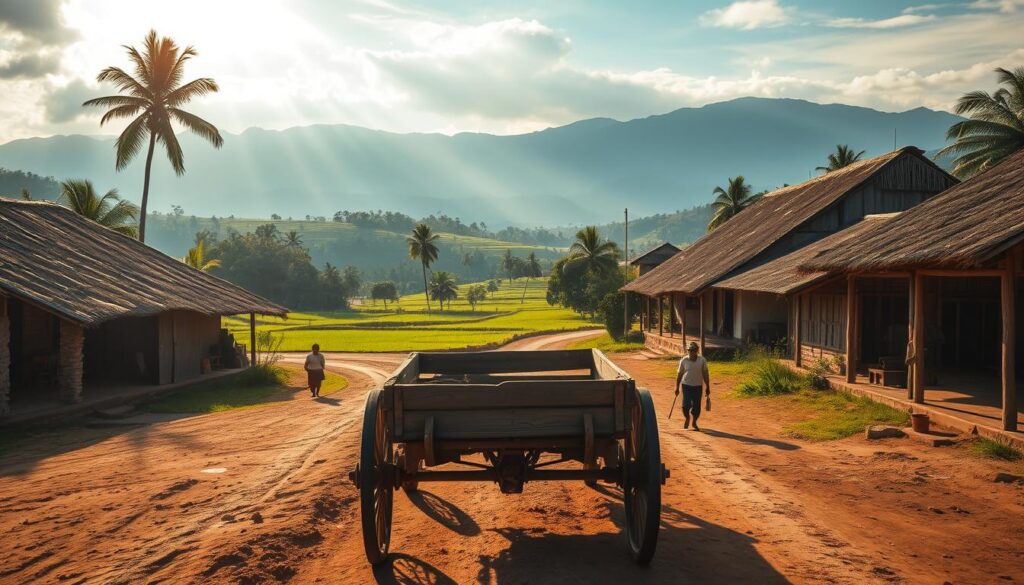
How to Get There
From Manila, take buses like Genesis or Five Star to Cabanatuan City (3-4 hours). Transfer to jeepneys bound for Aliaga’s main plaza. Key travel details:
- Last-mile transport: Tricycles reach Bibiclat in 20 minutes
- Best departure: Night before June 24 to catch 4 AM rituals
- Landmark: Diocesan Shrine’s bronze mud people statues
Local Tips for Visitors
Wear quick-dry clothing – you’ll navigate muddy paths during pagsa-san juan processions. Essential items include:
- Reusable water bottles (refill stations available)
- Waterproof bags for valuables
- Small bills for alms offerings
Book lodgings in Cabanatuan City, like Microtel Inn, 45 minutes from event grounds. After rituals, try local specialties: suman rice cakes or tinolang manok at family-run eateries.
Conclusion
Each June, a small Philippine ecija village revives a wartime miracle through earth and faith. Bibiclat’s annual observance, held every 24th, transforms personal gratitude into a communal testament. The ritual’s mud-coated figures and banana-leaf attire mirror St. John the Baptist’s wilderness life, blending biblical symbolism with local history.
What began as a World War survival tactic now draws global visitors. Processions pulse with shared purpose – barefoot devotees collecting alms, families sharing wartime stories, and travelers witnessing living heritage. Practical preparations like early arrivals and waterproof gear ensure meaningful participation.
This village celebrates more than history. Through mud-caked skin and humble offerings, residents honor devotion st. John modeled. The event bridges generations, with elders teaching children how banana leaves become sacred garments.
Bibiclat’s doors stay open to all seeking cultural connection. Whether you join the dawn march or simply observe, the experience leaves lasting impressions. Come June, let this unique ecija village show how faith and history shape enduring traditions.



